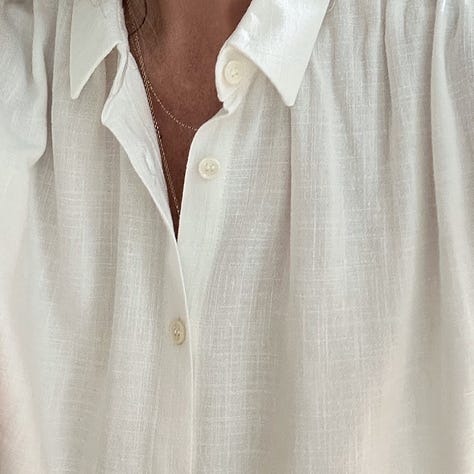
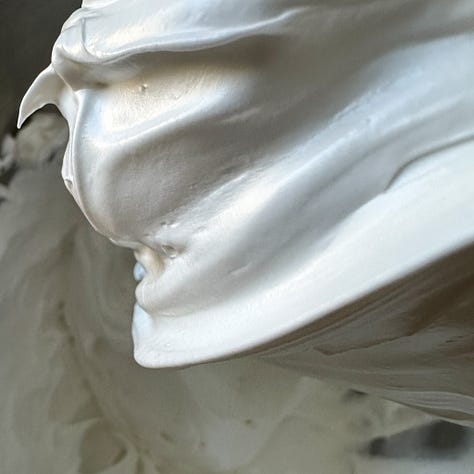
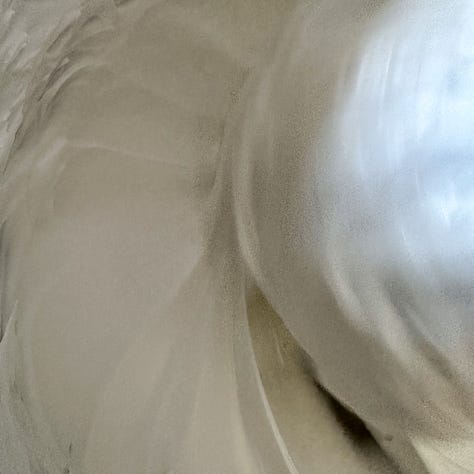
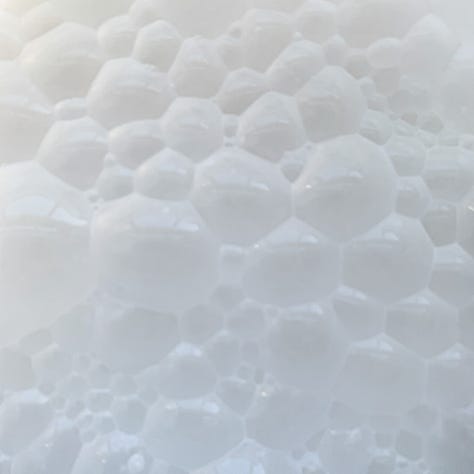

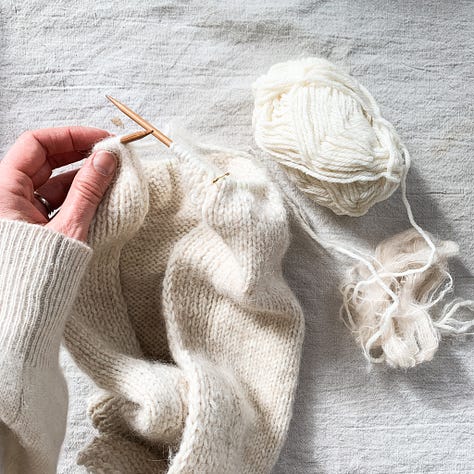
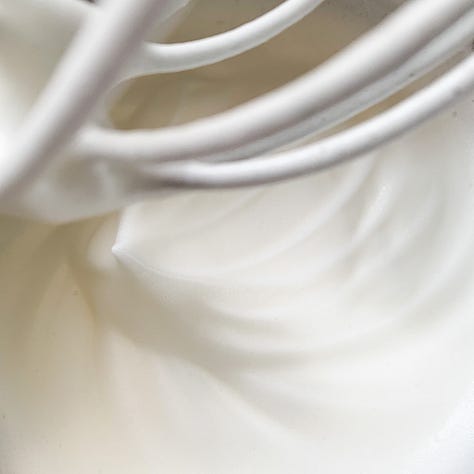
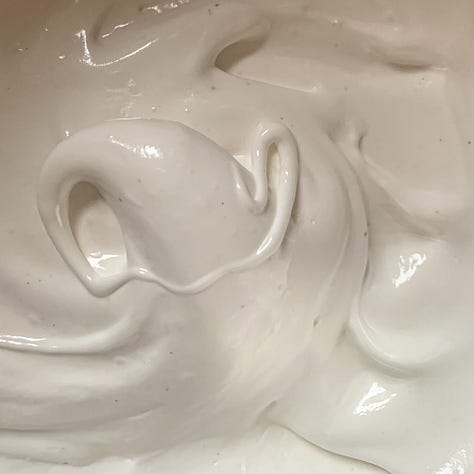
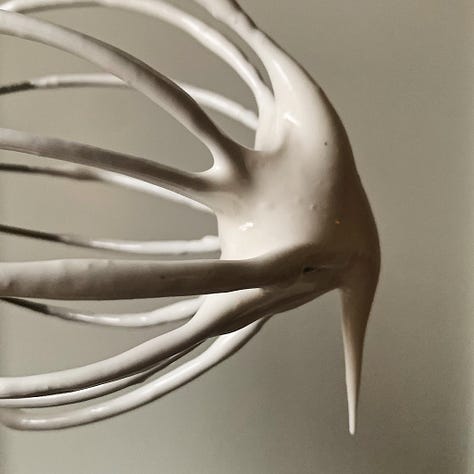
I love Libby, the library app on my phone. Libby doesn’t always have what I want, so I put books on hold and they pop up weeks, sometimes months later like a forgotten present. Libby has books that can be downloaded onto your phone, but I use her for audio books exclusively. Audio books are what I fall asleep to, what I put on in the car, pop into my ears when I’m pulling weeds or walking with Dottie.
I’ve been on a murder mystery jag lately. Libby has a large Agatha Christie catalog, so I’ll be submerged in mid-twentieth century murderous Britain for quite some time. Last week Hercule Poirot and his best friend Hastings kept me company. Audio gets woven into activities for me - Poirot is now in the row of goutweed that sneaks under my fence, Miss Marple is in the weeds between the flagstones, and Poirot and Hastings are now part of last Thursday morning on Lawrencetown beach. I had just dropped kids at surf camp, so took the opportunity to walk the foggy beach with Dottie. My mind wondered at times, especially when Hastings, the not as clever sidekick who is slow to see clues, drops words beyond my vocabulary. Interpolated. Timorous. Truculent. Hastings is faster than I am.
I was walking over the sand dunes in the gray of the morning when Poirot tells Hastings how he was going to approach the extraction of information from a collection of murder suspects. Does he suspect these people from holding things back, asks Hastings? Poirot replies,
“Not intentionally, but telling everything you know always implies selection. If I were to say to you, recount me your day yesterday you would reply, ‘I rose at 9, I breakfasted at half past, I had eggs and bacon and coffee, I went to my club,’ etc. You would not include, ‘I tore my nail and had to cut it, I rang for shaving water, I spilled a little coffee on a table cloth, I brushed my hat, I put it on.’ One cannot tell everything. One selects.”
It’s true, one does select.
I could say that last week, when I was supposed to be finishing this newsletter for its regular Friday delivery, I got sidetracked at my friend’s cottage eating egg salad sandwiches on the sandbar. I could hold back that I burnt my knees, threw a stick to my relentless dog until my hands got so sandy and that the Hello Dolly squares1 that Lynne served after the sandwiches were gritty between my teeth. Or that later that evening I drove with my sister to our cottage with three kids, two dogs, grocery bags, clean laundry baskets and weekend bags stuffed at our feet and I dripped mustard onto a dog’s head when we ate onions rings and burgers from the Dairy Queen drive-thru. Or that when we arrived at the cottage at dusk, I considered cracking open the laptop and finishing what I had started, but instead I read in bed while swatting at mosquitoes.
People also hold back when writing recipes. We make assumptions when we cook, moving through the kitchen intuitively, adding a pinch of something, smelling, tasting, and augmenting without writing it down. This is why one needs a Hastings to ask questions in the kitchen.
Where was Hastings last week when I made a pavlova here at the cottage? It was a last minute decision, based on - you guessed it - what I had in the kitchen: strawberries, mint, sugar and egg whites leftover from a key lime pie. I posted a picture that night of the thick white pavlova, baked in a cast iron pan because the other pan was in use. A few messaged me later asking how the pavlova turned out so white? I had no clue. I had held details back as I cooked.
Pavlova is an Australian / New Zealand dessert (both countries claim it as their own?) created to honour the Russian ballerina Anna Pavlova when she was touring in the 1920’s. Unlike traditional meringue, pavlova is meant to be light and airy on the inside, like a ballerina (or as I like to describe it, a marshmallowy pillow of tulle inside a crispy meringue, piled high with something creamy and a symphony of seasonal fruit). My mom started making pavlova after my Dad had a heart attack in the late 1990’s, when low fat yet sugary desserts were acceptable for cardiac conditions. She topped hers with low fat yogurt instead of the traditional whipped cream. I got used to the tang of yogurt, so now I split the difference and slather full fat Greek yogurt over the top - 11% if I can find it.
The pavlova that night was really very white, almost a Pantone Blanc de Blanc 11 4800 white. The white of cotton, of milk, of glossy whipped whites, of granulated sugar, of snow slicked with ice. The internet tells me a golden pavlova - a tone closer to Sugar Swizzle Pantone 11 0607 - might be because the oven was too hot, or that vanilla, not a traditional ingredient in pavlova, tinted the mixture. I didn’t use vanilla that night at the cottage. I cooked the pavlova in an oven preheated to 350F, then I turned the oven down to 200F when the pavlova went it. A hint of heat is really all a pavlova needs to cook.
I could also say that kids and dogs were flowing in and out of the cottage the afternoon I made pavlova. Or that I swatted at flies while slowly adding the sugar to the egg whites. Or that our friends were visiting with their kids, that I washed my hair in the shower outside, and that we ate snow crab pasta for dinner, like we do every summer.
Pavlova
serves 6
4 large egg whites, at room temperature
1 cup (200g) granulated sugar - extra credit if you blitz it in a food processor to make it extra fine - this helps the sugar dissolve faster in the egg whites
½ teaspoon cream of tartar - or substitute 1 teaspoon lemon juice, that’s what I did
1 teaspoon cornstarch
Toppings
- thick Greek yogurt or whipped cream
- fresh fruit - I used a pint of strawberries tossed with a touch of sugar and freshly chopped mint
Preheat the oven to 350F.
Line a baking sheet (or a 12 inch cast iron pan) with parchment paper. Using a stand mixture or hand mixer on medium speed, whisk egg whites until foamy but not stiff. Slowly add the sugar, one teaspoon at a time, until all the sugar has been added. Turn up the speed to high and whisk until whites are stiff and glossy, about two minutes. This is when I stop to marvel at the graphic shapes the whisk makes in the whites, and I take a picture. Slowly fold in the cream of tartar (or lemon juice) and cornstarch until incorporated.
Spread mixture, with a spoon or spatula, onto parchment paper to form a circle about 8 inches wide. You can be as swirly and wavy as you like here, but the idea is for the pavlova to be slightly higher on the sides and lower in the middle, like a low sided nest.
Slide pavlova into the oven and immediately turn the heat down to 200F. Leave it to bake until the pavlova is firm and dry, about 90 minutes. At this point I turn off the oven and leave the pavlova in there until needed. This keeps hands from sampling bits when they walk by. Wrap up and store covered for up to two days if not eating that day.
While the pavlova was cooling in the oven, I asked a kid to hull and cut the strawberries into quarters. I tossed them in a teaspoon of sugar and a handful of finely chopped mint. It’s nice to let the strawberries macerate in the mint and sugar for at least an hour, covered, before serving.
When ready to eat, spoon thick yogurt (or freshly whipped cream) onto the pavlova and top with berries. Enjoy.
Hello Dollies are my favourite. If you don’t know them, imagine a chewy, crunchy sweet bite filled with graham crackers, shaved coconut, walnuts and chocolate chips held together in a thick, gooey sweetened condensed milk mixture. Would you like the recipe in a future newsletter?
PS Remember the chicken marinade with a can a ginger ale I mentioned in my latest podcast episode with Jill Barber? I’ll include the recipe in my next newsletter. It’s a good one.




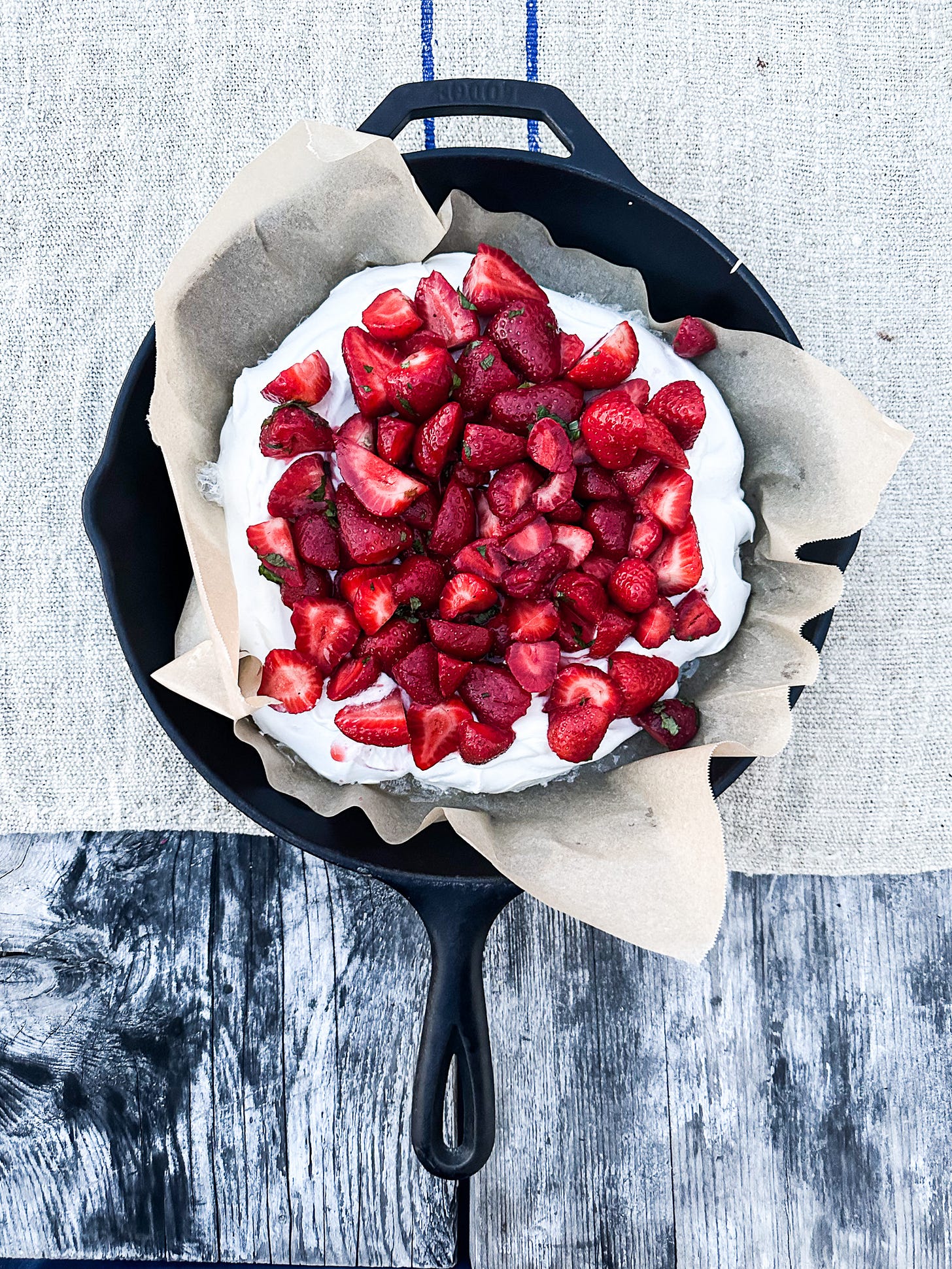
Um ... definitely yes on the Hello Dollies.
English murder mysteries and scrawled recipies! There's always something more to uncover. Love this post!